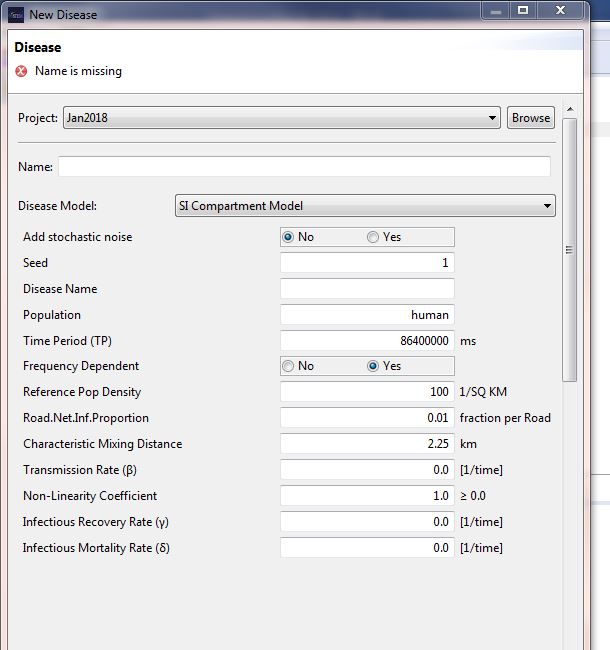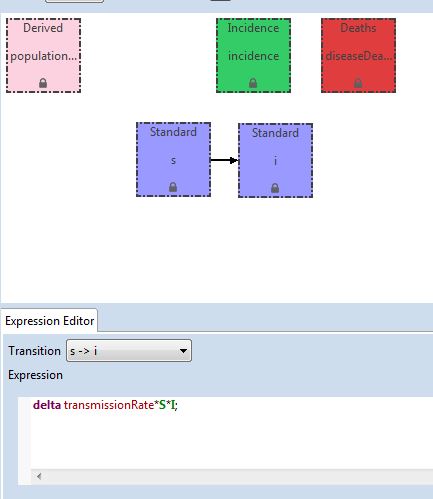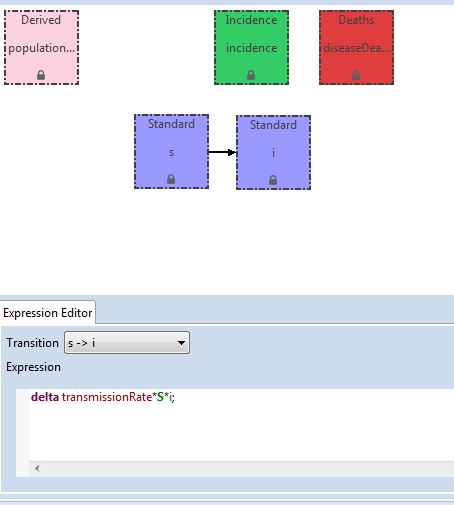Notice: this Wiki will be going read only early in 2024 and edits will no longer be possible. Please see: https://gitlab.eclipse.org/eclipsefdn/helpdesk/-/wikis/Wiki-shutdown-plan for the plan.
STEM Frequency Density Dependent Transmission
According to Begon et al. (2002), there are three elements to consider in terms of frequency- and density- dependent transmission in disease models:
Area
Number of infected individuals
Number of infected individuals as a proportion of the whole population (population density)
This page will discuss how these elements are modelled in STEM.
Frequency- and density-dependent option in STEM disease models
In STEM, the option to select whether a model is frequency dependent (“Yes” or “No) in the disease model is referring to whether the area of nodes should be taken into consideration when scaling the transmission rate. In a STEM frequency-dependent model, area is not taken into consideration, whereas in a density-dependent model, the transmission rate is scaled by the area in every location. The scaling factor is populationDensity/referencePopulationDensity.
Areas of nodes are able to be specified as labels in some STEM graphs. However, the transmission rate will not scale linearly with the physical area given, instead it will be scaled according to the “reference population density” parameter which can be specified according to the clustering behaviour of the population. This will give an “effective area”. In some senses, although this is labelled “density-dependency” in STEM, this is still giving an element of frequency-dependency, where, regardless of the population density, the number of contacts each individual has remains the same. Therefore, best practice is to select “No” for “Frequency Dependent” in STEM if you want to take area into consideration (remembering that this will be the “effective area”), or “Yes” if you do not want area to be considered when calculating the transmission rate. Incorporating the other aspects of frequency- and density- dependent transmission can be included when building your own disease model in the model creator.
Specifying frequency- and density- dependent transmission in the Model Creator
Frequency- and density- dependent transmission in terms of population density or number of infected individuals, can be specified when writing the STEM expression for the S->I transition in the model creator for custom models https://wiki.eclipse.org/STEM_Model_Creator . As specified on the wiki page for the STEM Expression Language, https://wiki.eclipse.org/STEM_Expression_Language : indicates the absolute population count in the ‘infected’ compartment indicates I/N, in which N is the total population count of all the compartments, giving the population density.
This is the rate equation for the infectious compartment for “density- dependent transmission” (Begon, et al., 2002):
dI/dt= βS*I/A
where β is the transmission coefficient, S is the number of individuals in the susceptible compartment, I is the number of individuals in the infectious compartment and A is area. We can assume that area is constant, as this is taken into consideration in STEM as explained above, therefore, A = 1, which leaves: dI/dt= βSI
In the STEM Model Creator, this can be specified as:
This is the rate equation for the infectious compartment for “frequency- dependent transmission” (Begon, et al., 2002):
dI/dt= β'S*I/N
where N is the total number of individuals in all compartments. In STEM, this can be specified as:
The paper by Begon et al. (2002) has more information on these issues, as well as this blog (Parasite Ecology, 2013).
Bibliography
Begon, M. et al., 2002. A clarification of transmission terms in host-microparasite models: numbers, densities and areas. Epidemiology and Infection, Volume 129, pp. 147-153.
Parasite Ecology, 2013. Density-dependent vs. Frequency-dependent Disease Transmission. [Online] Available at: https://parasiteecology.wordpress.com/2013/10/17/density-dependent-vs-frequency-dependent-disease-transmission/ [Accessed 6 March 2019].



